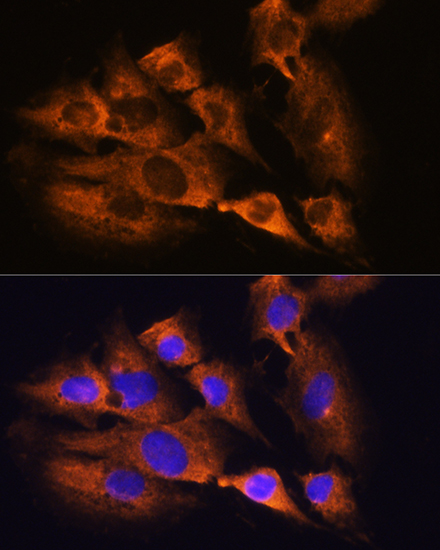Neuroscience
Anti-ACHE Antibody (CAB2806)
- SKU:
- CAB2806
- Product Type:
- Antibody
- Reactivity:
- Human
- Reactivity:
- Mouse
- Reactivity:
- Rat
- Host Species:
- Rabbit
- Isotype:
- IgG
- Research Area:
- Neuroscience
Description
| Antibody Name: | Anti-ACHE Antibody |
| Antibody SKU: | CAB2806 |
| Antibody Size: | 20uL, 50uL, 100uL |
| Application: | WB IHC IF |
| Reactivity: | Human, Mouse, Rat |
| Host Species: | Rabbit |
| Immunogen: | Recombinant fusion protein containing a sequence corresponding to amino acids 398-617 of human ACHE (NP_056646.1). |
| Application: | WB IHC IF |
| Recommended Dilution: | WB 1:500 - 1:2000 IHC 1:50 - 1:100 IF 1:50 - 1:200 |
| Reactivity: | Human, Mouse, Rat |
| Positive Samples: | SH-SY5Y, SGC996, Mouse brain, Mouse spinal cord, Mouse liver, Rat spinal cord |
| Immunogen: | Recombinant fusion protein containing a sequence corresponding to amino acids 398-617 of human ACHE (NP_056646.1). |
| Purification Method: | Affinity purification |
| Storage Buffer: | Store at -20'C. Avoid freeze / thaw cycles. Buffer: PBS with 0.02% sodium azide, 50% glycerol, pH7.3. |
| Isotype: | IgG |
| Sequence: | VPQV SDLA AEAV VLHY TDWL HPED PARL REAL SDVV GDHN VVCP VAQL AGRL AAQG ARVY AYVF EHRA STLS WPLW MGVP HGYE IEFI FGIP LDPS RNYT AEEK IFAQ RLMR YWAN FART GDPN EPRD PKAP QWPP YTAG AQQY VSLD LRPL EVRR GLRA QACA FWNR FLPK LLSA TASE APST CPGF THGE AAPR PGLP LPLL LLHQ LLLL FLSH LRRL |
| Gene ID: | 43 |
| Uniprot: | P22303 |
| Cellular Location: | Cell junction, Cell membrane, Extracellular side, GPI-anchor, Lipid-anchor, Nucleus, Peripheral membrane protein, Secreted, synapse |
| Calculated MW: | 58kDa/65kDa/67kDa |
| Observed MW: | 75kDa |
| Synonyms: | ACHE, ACEE, ARACHE, N-ACHE, YT |
| Background: | Acetylcholinesterase hydrolyzes the neurotransmitter, acetylcholine at neuromuscular junctions and brain cholinergic synapses, and thus terminates signal transmission. It is also found on the red blood cell membranes, where it constitutes the Yt blood group antigen. Acetylcholinesterase exists in multiple molecular forms which possess similar catalytic properties, but differ in their oligomeric assembly and mode of cell attachment to the cell surface. It is encoded by the single ACHE gene, and the structural diversity in the gene products arises from alternative mRNA splicing, and post-translational associations of catalytic and structural subunits. The major form of acetylcholinesterase found in brain, muscle and other tissues is the hydrophilic species, which forms disulfide-linked oligomers with collagenous, or lipid-containing structural subunits. The other, alternatively spliced form, expressed primarily in the erythroid tissues, differs at the C-terminal end, and contains a cleavable hydrophobic peptide with a GPI-anchor site. It associates with the membranes through the phosphoinositide (PI) moieties added post-translationally. |
| UniProt Protein Function: | ACHE: Terminates signal transduction at the neuromuscular junction by rapid hydrolysis of the acetylcholine released into the synaptic cleft. Role in neuronal apoptosis. Belongs to the type-B carboxylesterase/lipase family. 4 isoforms of the human protein are produced by alternative splicing. |
| UniProt Protein Details: | Protein type:EC 3.1.1.7; Hydrolase; Membrane protein, GPI anchor; Lipid Metabolism - glycerophospholipid Chromosomal Location of Human Ortholog: 7q22 Cellular Component: Golgi apparatus; extracellular space; cell surface; membrane; perinuclear region of cytoplasm; plasma membrane; extracellular region; synapse; basal lamina; nucleus; neuromuscular junction; cell junction Molecular Function:collagen binding; serine hydrolase activity; protein binding; protein homodimerization activity; protein self-association; cholinesterase activity; hydrolase activity; beta-amyloid binding; laminin binding; acetylcholinesterase activity; acetylcholine binding Biological Process: negative regulation of synaptic transmission, cholinergic; nervous system development; muscle development; acetylcholine catabolic process in synaptic cleft; acetylcholine catabolic process; glycerophospholipid biosynthetic process; osteoblast development; cell proliferation; synaptic transmission; synaptogenesis; positive regulation of protein secretion; amyloid precursor protein metabolic process; retina development in camera-type eye; receptor internalization; phospholipid metabolic process; neurotransmitter receptor biosynthetic process; response to wounding; phosphatidylcholine biosynthetic process; regulation of receptor recycling; DNA replication; cell adhesion; protein tetramerization; neurotransmitter biosynthetic process Disease: Yt Blood Group Antigen |
| NCBI Summary: | Acetylcholinesterase hydrolyzes the neurotransmitter, acetylcholine at neuromuscular junctions and brain cholinergic synapses, and thus terminates signal transmission. It is also found on the red blood cell membranes, where it constitutes the Yt blood group antigen. Acetylcholinesterase exists in multiple molecular forms which possess similar catalytic properties, but differ in their oligomeric assembly and mode of cell attachment to the cell surface. It is encoded by the single ACHE gene, and the structural diversity in the gene products arises from alternative mRNA splicing, and post-translational associations of catalytic and structural subunits. The major form of acetylcholinesterase found in brain, muscle and other tissues is the hydrophilic species, which forms disulfide-linked oligomers with collagenous, or lipid-containing structural subunits. The other, alternatively spliced form, expressed primarily in the erythroid tissues, differs at the C-terminal end, and contains a cleavable hydrophobic peptide with a GPI-anchor site. It associates with the membranes through the phosphoinositide (PI) moieties added post-translationally. [provided by RefSeq, Jul 2008] |
| UniProt Code: | P22303 |
| NCBI GenInfo Identifier: | 113037 |
| NCBI Gene ID: | 43 |
| NCBI Accession: | P22303.1 |
| UniProt Secondary Accession: | P22303,Q16169, Q29S23, Q2M324, Q504V3, Q53F46, Q86TM9 Q86YX9, Q9BXP7, A4D2E2, B7ZKZ0, D6W5X7, |
| UniProt Related Accession: | P22303 |
| Molecular Weight: | 58,352 Da |
| NCBI Full Name: | Acetylcholinesterase |
| NCBI Synonym Full Names: | acetylcholinesterase (Yt blood group) |
| NCBI Official Symbol: | ACHE |
| NCBI Official Synonym Symbols: | YT; ACEE; ARACHE; N-ACHE |
| NCBI Protein Information: | acetylcholinesterase; Yt blood group; apoptosis-related acetylcholinesterase |
| UniProt Protein Name: | Acetylcholinesterase |
| Protein Family: | Achelase |
| UniProt Gene Name: | ACHE |
| UniProt Entry Name: | ACES_HUMAN |











